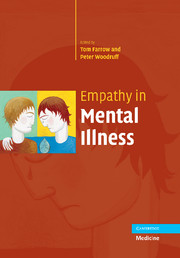Book contents
- Frontmatter
- Contents
- Foreword
- List of contributors
- Part I ‘Dysempathy’ in psychiatric samples
- Part II Empathy and related concepts in health
- 9 Neonatal antecedents for empathy
- 10 The evolutionary neurobiology, emergence and facilitation of empathy
- 11 Naturally occurring variability in state empathy
- 12 Neuroimaging of empathy
- 13 The neurophysiology of empathy
- 14 The cognitive neuropsychology of empathy
- 15 The genetics of empathy and its disorders
- 16 Empathogenic agents: their use, abuse, mechanism of action and addiction potential
- 17 Existential empathy: the intimacy of self and other
- 18 Empathizing and systemizing in males, females and autism: a test of the neural competition theory
- 19 Motivational-affective processing and the neural foundations of empathy
- 20 Face processing and empathy
- Part III Empathy models, regulation and measurement of empathy
- Index
16 - Empathogenic agents: their use, abuse, mechanism of action and addiction potential
from Part II - Empathy and related concepts in health
Published online by Cambridge University Press: 17 August 2009
- Frontmatter
- Contents
- Foreword
- List of contributors
- Part I ‘Dysempathy’ in psychiatric samples
- Part II Empathy and related concepts in health
- 9 Neonatal antecedents for empathy
- 10 The evolutionary neurobiology, emergence and facilitation of empathy
- 11 Naturally occurring variability in state empathy
- 12 Neuroimaging of empathy
- 13 The neurophysiology of empathy
- 14 The cognitive neuropsychology of empathy
- 15 The genetics of empathy and its disorders
- 16 Empathogenic agents: their use, abuse, mechanism of action and addiction potential
- 17 Existential empathy: the intimacy of self and other
- 18 Empathizing and systemizing in males, females and autism: a test of the neural competition theory
- 19 Motivational-affective processing and the neural foundations of empathy
- 20 Face processing and empathy
- Part III Empathy models, regulation and measurement of empathy
- Index
Summary
Many substances promote empathy, but the most common are ecstasy (MDMA) like and some newer chemical molecules like ketamine, phencyclidine and LSD. We suggest however that substances that are not inherently empathetic (e.g. smart drugs) can also fulfil this function.
Research underlines the possible role of serotonergic neurotransmitters and the involvement of mirror neurons in this type of empathy seeking behaviour. From a clinical point of view, it is important to highlight the difference between these two situations, as it will impact on the type of care proposed and on the global understanding we have of drug consumption phenomena, especially among young people, most of whom are recreational users.
Introduction
In a society driven by ‘performance worship’ (Ehrenberg, 1991), and where the notion of individuality is breaking up, relationships between individuals are more and more based on power and competition. Solitude, feelings of incompleteness, withdrawal into oneself and difficulties being noticed by peers are signs of being a misfit and of poor psychosocial integration (Alexander, 1990; Erickson, 1963). The recourse to self-medication and psychoactive substances that can modify one's state of consciousness, mood and thought processes (sometimes using prescription medicines, but mainly illegal drugs) is continuously growing. This recourse to self-medication can be seen as a behavioural adaptation and a way of dealing with problems in life (addiction, marginality, criminality, self-consciousness, anxiety, depression and suicidality).
- Type
- Chapter
- Information
- Empathy in Mental Illness , pp. 289 - 309Publisher: Cambridge University PressPrint publication year: 2007
- 2
- Cited by



